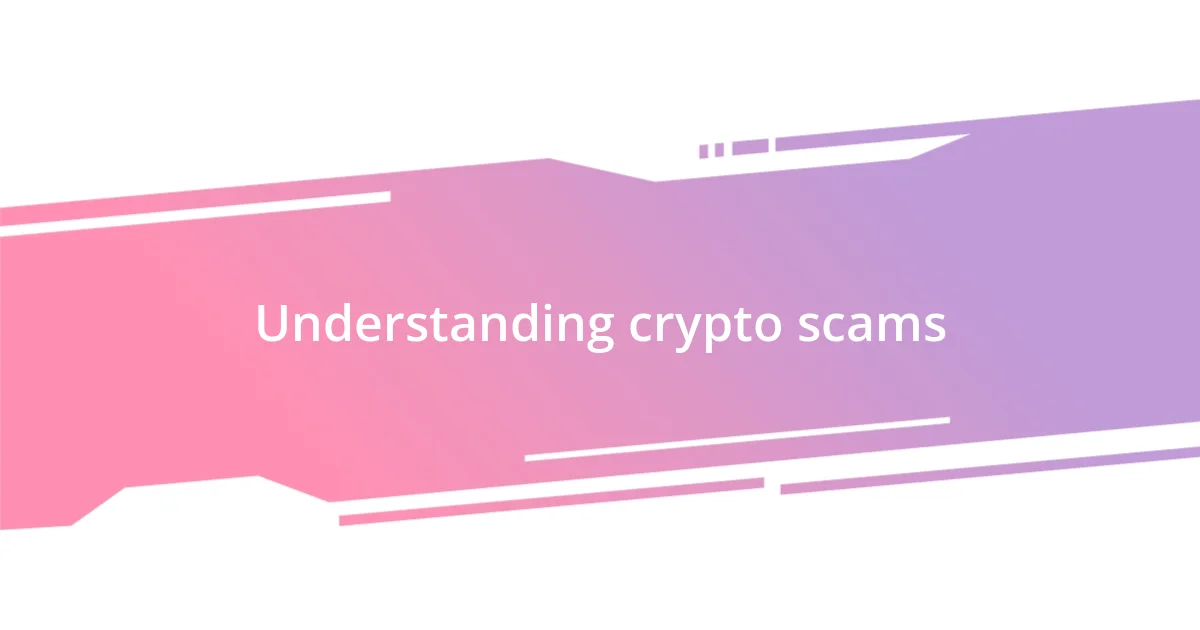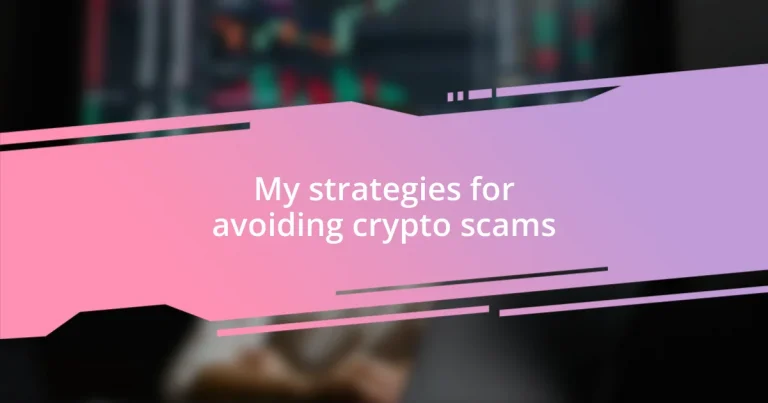Key takeaways:
- Trusting instincts and being aware of common phishing tactics, such as urgency and pressure, can help individuals avoid crypto scams.
- Using reliable platforms with strong security features, regulatory compliance, and responsive customer support is essential for safeguarding investments.
- Continuous education, thorough research of projects, and timely reporting of suspicious activities contribute significantly to personal and community safety in the crypto space.

Understanding crypto scams
Crypto scams often take on sophisticated forms, exploiting the allure of digital currencies. I vividly recall my first encounter with a “too good to be true” investment opportunity advertised on social media. The excitement of potentially doubling my money in a month was overshadowed by a gut feeling that something didn’t add up—trust your instincts, especially in a volatile space like cryptocurrency.
Fraudsters frequently use phishing tactics, tricking individuals into revealing sensitive information. I once received an email that looked just like a notification from a major exchange. The urgency in the message was palpable, almost like a voice whispering, “Act now or miss out!” It made me realize how effective these scams can be at preying on our fears and aspirations.
Understanding these scams is crucial for anyone navigating the crypto landscape. Why do some people fall for these traps while others remain vigilant? I believe it often comes down to awareness and education; the more we learn about these tactics, the better equipped we are to protect ourselves. Keeping informed is not just a safety measure; it’s empowering.

Recognizing red flags
Recognizing red flags is essential in the world of cryptocurrency. During my experience, I’ve noticed a pattern: scammers thrive on urgency and pressure. One time, I came across a crypto project that insisted I invest immediately to “secure my spot.” The palpable anxiety around the offering gave me pause. That was my cue to step back and reflect on the situation; real investment opportunities don’t rush you into decisions.
Here are some telltale signs to watch out for:
- Promises of guaranteed returns that seem too good to be true.
- Pressure tactics urging you to act quickly or miss out.
- Unclear or complex explanations of how the investment works.
- Lack of transparency regarding the team’s identity or background.
- Unverified endorsements from online personas or influencers.
- Poorly designed websites with numerous grammatical errors.
By keeping these warning signs in mind, you can cultivate a more discerning approach to crypto investments. Always trust your gut; it’s more than just intuition—it’s your protective instinct at work.

Using reliable platforms
Using reliable platforms is fundamental in my approach to avoiding crypto scams. Whenever I consider trading or investing, I always prioritize established exchanges and wallets. I remember signing up for a lesser-known platform in my early days, only to realize later that it lacked the security measures I had taken for granted. The anxiety that came from not knowing if my funds were safe is something I never want to experience again. Stick to platforms with a strong reputation and positive user reviews; you cannot underestimate the value of community feedback.
I also emphasize the importance of checking regulatory compliance. Once, I came across a crypto wallet that seemed perfect on the surface but was inconspicuously based in a jurisdiction with little oversight. I felt a mix of frustration and fear when I realized I might have been risking my assets. Reliable platforms are usually registered with local authorities and adhere to strict regulations. This not only provides peace of mind but also ensures that user funds are managed properly.
In addition, I can’t stress enough the significance of transparent customer support. I had a minor issue with a trade on a reputable platform, and their responsive team resolved it swiftly. That support gave me confidence that they were invested in their users’ safety. Remember, if a platform has limited or no customer service options, it might be a red flag. Investing in platforms that prioritize user experience can be the difference between a secure investment and a potential disaster.
| Criteria | Reliable Platforms |
|---|---|
| Security Features | Multi-factor authentication, cold storage |
| Regulatory Compliance | Registered with authorities |
| Customer Support | Responsive, available 24/7 |
| User Feedback | Positive reviews, community trust |

Implementing multi-factor authentication
Implementing multi-factor authentication (MFA) has become a cornerstone of my security strategy in the crypto realm. The first time I set it up on my exchange account, I felt an overwhelming sense of relief. I thought to myself, “Why didn’t I do this sooner?” MFA adds an essential layer of protection by requiring not just a password, but also an additional verification step, like a text message code or an authentication app prompt. This drastically reduces the likelihood of unauthorized access to my funds.
I can recall a moment when I nearly fell victim to a phishing attempt. An email looked strikingly like it was from my crypto exchange, urging me to log in immediately. Had I not had MFA enabled, I shudder to think how much I could have lost. This added step—in my experience, it’s worth every second it takes to enter that verification code. It keeps the opportunistic fraudsters at bay and provides an added ounce of control over my digital assets.
Furthermore, I often ask myself how many friends or family members overlook setting up MFA. I’ve shared my experiences with them, emphasizing how simple and effective it is. The reassurance that comes from knowing I’ve gone the extra mile to secure my holdings is empowering. When everyone can choose to invest in their security, why wouldn’t we take that step? Trust me, enabling MFA is not just a wise choice; it’s a necessary one in today’s crypto environment.

Researching projects thoroughly
Researching projects thoroughly is essential in today’s crypto landscape. My experience has taught me that diving deep into a project can be the difference between a wise investment and a costly mistake. I recall a project that appeared promising at first glance—the white paper was sleek, and the team members boasted impressive resumes. But the more I researched, the more I found discrepancies in their claims. It left me thinking, “How much do we really know about the faces behind the code?” This experience solidified my belief that initial impressions can be misleading.
I always take the time to look beyond the surface. Engaging in online communities, such as forums and social media groups, can reveal valuable insights that aren’t found in official channels. One time, I stumbled across a lively discussion about a project facing criticism for its lack of transparency. While the initial marketing seemed brilliant, this chatter made me pause. I asked myself, “If others are raising red flags, should I be cautious too?” Ultimately, those conversations confirmed my instincts and kept my investment safe.
Sometimes, the technical aspects can be daunting, but I remind myself to parse through the jargon. Checking the project’s GitHub or development activity can tell you so much about its vitality. There was a project I almost backed, but upon reviewing its GitHub, I noticed it hadn’t been updated in months. I felt relieved to dodge that bullet! The enthusiasm I once felt transformed into gratitude for doing my homework. Investing time in research can lead to profound safety and confidence. In the ever-evolving world of crypto, thorough research isn’t just helpful; it’s vital.

Educating yourself continuously
I’ve come to appreciate that continuous education in the crypto space is invaluable. I remember the first time I attended a webinar on blockchain technology; it opened my eyes to concepts I never fully understood before. It’s incredible how much insight can come from simply listening to experts in the field share their knowledge. Who knew that a two-hour session could reshape my entire perspective on safe investing?
Each week, I dedicate a little time to reading up on market trends and regulatory changes. This habit has helped me make informed decisions rather than reacting impulsively. Recently, I came across an article discussing the rise of decentralized finance (DeFi) protocols. It not only boosted my understanding but also prompted me to reassess my own investment strategies. I often ask myself, “What if I had skimmed past that article? How many opportunities would I have missed?” The answer, I realize, is plenty.
Joining online communities has also been a game-changer in my learning journey. I love sharing thoughts with others who are just as passionate about crypto. In one chat, someone shared their experience with a scam that nearly cost them everything. Hearing their story solidified my desire to stay vigilant and keep learning. Each of these interactions is a reminder to me that knowledge shared is knowledge gained, and the importance of educational resources can’t be overstated. Just think—when was the last time you learned something new that changed your approach?

Reporting suspicious activities
Reporting suspicious activities is a critical step in protecting ourselves and the broader crypto community. I distinctly remember the uneasy feeling I got when I received an unsolicited direct message on social media claiming I had won a crypto giveaway. It seemed too good to be true, and I couldn’t shake the feeling that it was a scam. Reporting that account not only helped shield myself but could potentially protect others from falling into the same trap.
I also keep in mind that timely reporting can make a significant difference. There was a time when I spotted a bizarre transaction on my wallet from a project I was familiar with—one that had turned out to be a scam in the past. Without hesitation, I reported it to the wallet provider. The relief I felt knowing I might have contributed to stopping further victimization still resonates with me. Have you ever thought about the weight of your own vigilance? It’s profound to realize that your actions can help maintain the integrity of the crypto environment.
Using official platforms to report suspicious activities is crucial. I recall feeling empowered after learning about the channels available to alert authorities about potential fraud. Submitting those reports can feel like a small act, yet it plays a significant role in combatting the churning tide of scams and fraudulent schemes. Reflecting on it now, I realize that the more we participate in this collective effort, the safer our community becomes. So, the next time something doesn’t feel right, ask yourself: “Am I doing my part to keep this space secure?”














